How to Use Blockchain in Healthcare: What You Must Know
- BLOG
- Blockchain
- October 15, 2025
Managing patient data in healthcare has always been a struggle. Privacy concerns, inefficiencies, and the risk of fraud are constant challenges that hinder progress. Traditional systems often fail to provide the level of security needed, and outdated processes slow everything down. That’s when blockchain technology comes in handy. So, how to use blockchain in healthcare? Blockchain can securely store and share patient data, ensuring transparency and reducing fraud. It creates an unchangeable ledger of transactions, making it easier to manage and verify records. Blockchain can also simplify billing processes and improve overall data access across healthcare systems. Keep reading to learn how blockchain can solve some common inconveniences, core benefits, and the step-by-step implementation process.
Contents
- 1 Understanding Blockchain in Simple Terms
- 2 How Blockchain Works in Healthcare
- 2.1 Step 1: Creating the Block
- 2.2 Step 2: The data block gets added to the chain
- 2.3 Step 3: The block is validated and locked
- 2.4 Step 4: Everyone with permission sees the same data
- 2.5 Step 5: Access is controlled by private permissions
- 2.6 Step 6: Smart contracts automate follow-up actions
- 2.7 Step 7: The entire history is always traceable
- 3 How to Use Blockchain in a Healthcare Setting (The Integration Steps)
- 3.1 Step 1: Define the Use Case
- 3.2 Step 2: Choose the Right Blockchain Platform
- 3.3 Step 3: Collaborate with Stakeholders
- 3.4 Step 4: Ensure Data Privacy and Regulatory Compliance
- 3.4.1 Use a Permissioned Blockchain
- 3.4.2 Encrypt All Sensitive Data
- 3.4.3 Limit Data Exposure (Minimum Necessary Rule)
- 3.4.4 Enable Role-Based Access Control (RBAC)
- 3.4.5 Avoid Immutable Storage of Identifiable Data
- 3.4.6 Conduct Regular Security & Compliance Audits
- 3.4.7 Align with HIPAA, GDPR, and Local Health Laws
- 3.5 Step 5: Pilot and Scale Gradually
- 3.6 Step 6: Integrate the Blockchain System
- 4 Launch blockchain in your healthcare service with Webisoft now!
- 5 Cost Analysis: What It Takes to Implement Blockchain in Healthcare
- 6 Why Healthcare Needs Blockchain
- 7 Patient Perspective: How Blockchain Impacts the Healthcare Experience
- 8 Challenges & Considerations of Blockchain in Healthcare
- 9 Innovative Approaches and Future Trends of Blockchain in Healthcare
- 10 How Can Webisoft Help You Adding Blockchain in Your Healthcare Service
- 11 Launch blockchain in your healthcare service with Webisoft now!
- 12 Conclusion
- 13 FAQs
Understanding Blockchain in Simple Terms
To understand how to use blockchain in healthcare, you need to understand blockchain first. Here are some crucial aspects that you need to learn:
The Core Ideas You Actually Need to Know
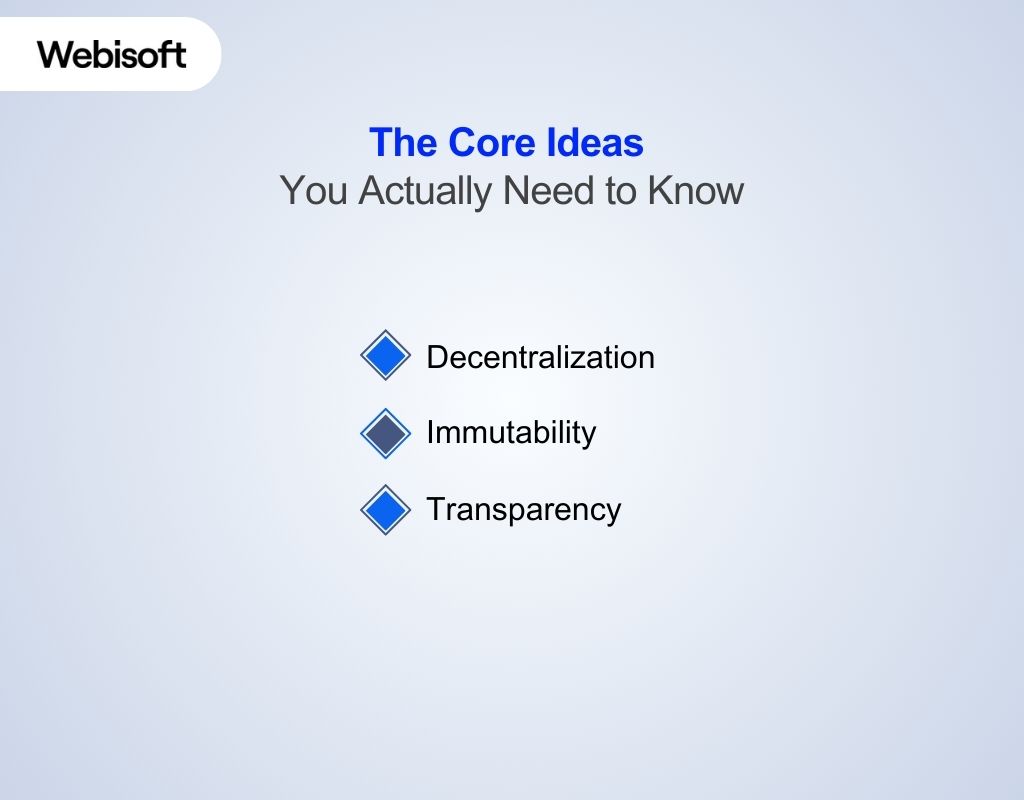 There are three concepts that matter most: decentralization, immutability, and transparency. Don’t worry, they’re not as abstract as they sound.
There are three concepts that matter most: decentralization, immutability, and transparency. Don’t worry, they’re not as abstract as they sound.
1. Decentralization
It means there’s no single owner of the data. Imagine a hospital, an insurer, and a pharmacy all accessing the same patient record; not copies, not versions, but the same source. That’s decentralization in blockchain database.
2. Immutability
This term refers to the fact that once data is in the system, it can’t be changed behind the scenes. If a change is needed, it’s added as a new record rather than edited in the old one. This helps keep records honest and traceable.
3. Transparency
It’s about controlled visibility. Everyone on the network sees the same data version, but they only access what they’re allowed to. So a patient might control who sees their medical history, while the hospital only accesses what’s been shared.
How Blockchain Works in Healthcare
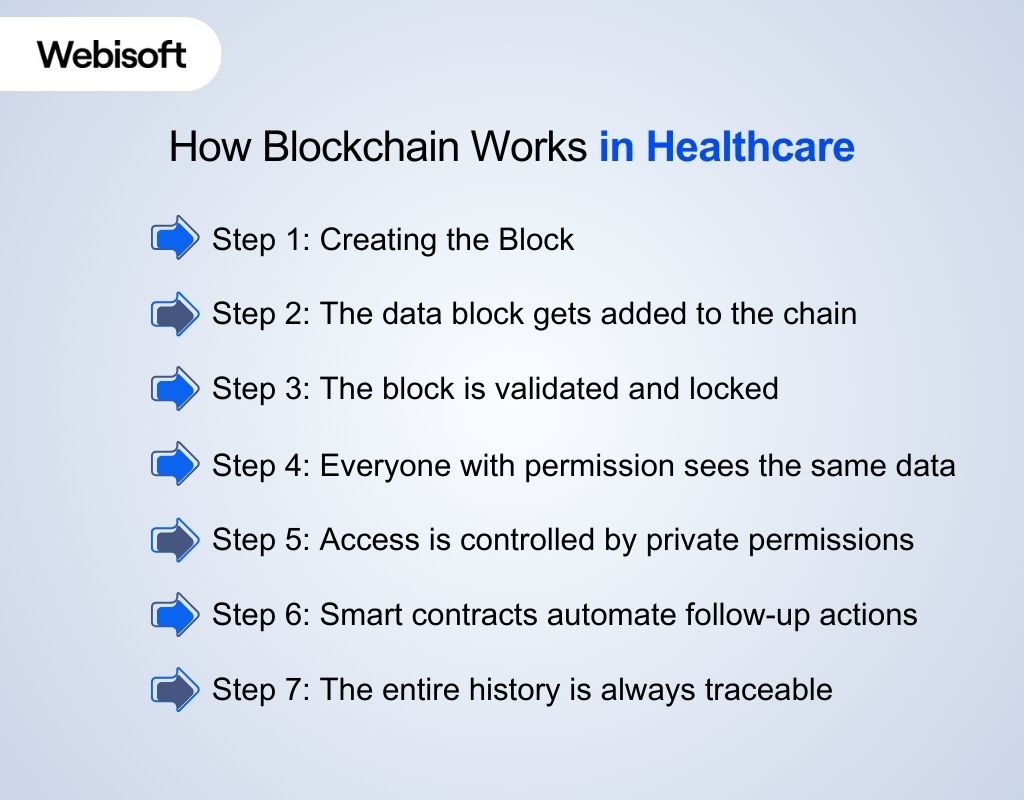 Here’s how blockchain in healthcare works in step-by-step:
Here’s how blockchain in healthcare works in step-by-step:
Step 1: Creating the Block
Let’s say a doctor updates a patient’s diagnosis or a lab sends test results. That action becomes a “block,” a single, timestamped entry tied to the patient’s unique ID.
Step 2: The data block gets added to the chain
This block isn’t saved in isolation. It’s permanently linked to the previous entries, creating a full, chronological history of the patient’s care. Nothing is overwritten; each update becomes part of the timeline.
Step 3: The block is validated and locked
Before it’s added, the network checks the data for consistency; this is like a built-in audit. Once approved, the block is sealed and can’t be edited without everyone knowing. If anything changes, a new block is created instead.
Step 4: Everyone with permission sees the same data
This is an important step when discussing how to use blockchain in healthcare. Here’s where blockchain really helps: all approved parties, like doctors, labs, and insurers, access the same version of the record in real time. No duplicate files. No delays. No missing pieces.
Step 5: Access is controlled by private permissions
Even though it’s shared, the system isn’t wide open. This is a private blockchain, so only trusted users can view or add data. Patients can also control who gets access to their info and for how long.
Step 6: Smart contracts automate follow-up actions
When certain conditions are met, like a treatment being recorded, smart contracts can automatically trigger the next steps. That might mean submitting a claim, releasing a referral, or notifying a care team.
Step 7: The entire history is always traceable
Every action is recorded in order. That makes it easy to audit, track care decisions, and prevent fraud. There’s no room for quiet edits or sketchy backdating.
How to Use Blockchain in a Healthcare Setting (The Integration Steps)
 Knowing how to use blockchain in healthcare is one thing, and making it work inside a live hospital or health system is another. Here’s a simple step-by-step guide on how to implement blockchain in healthcare:
Knowing how to use blockchain in healthcare is one thing, and making it work inside a live hospital or health system is another. Here’s a simple step-by-step guide on how to implement blockchain in healthcare:
Step 1: Define the Use Case
The first thing you have to do is find out the problem you want to fix. For example, are you fixing medical record access? Fighting billing fraud or streamlining prior authorizations? Don’t try to solve everything at once; nail one focused use case that shows real value fast. This approach gives you a solid starting point for understanding how to use blockchain in healthcare effectively.
Step 2: Choose the Right Blockchain Platform
Not all platforms are built for healthcare. The popular blockchain platforms for integrating into healthcare are:
- Ethereum: Open-source and flexible, but public by default. Best for transparency-driven projects, not ideal for handling sensitive patient data.
- Hyperledger Fabric: Permissioned and modular. Great for private healthcare networks that need fine-grained access control.
- Corda: Designed for regulated industries. Focuses on point-to-point data sharing; ideal for financial transactions and healthcare workflows.
How to use blockchain in healthcare smoothly is also influenced by your use case with the platform’s features, scalability, and security model. Hence, you need to match them properly.
Step 3: Collaborate with Stakeholders
Bring in IT, compliance, legal, operations, and clinical teams early. If even one of those groups is out of sync, the whole project slows or even dies. Align them on goals and responsibilities to make the operation successful.
Step 4: Ensure Data Privacy and Regulatory Compliance
 This isn’t optional. You’re dealing with patient data and complex laws. Here’s how to stay compliant while protecting patient data:
This isn’t optional. You’re dealing with patient data and complex laws. Here’s how to stay compliant while protecting patient data:
Use a Permissioned Blockchain
Public blockchains expose too much. Use a permissioned (private) blockchain where only approved participants can access and write data.
Encrypt All Sensitive Data
Never store raw patient data directly on the blockchain. Use off-chain storage with strong encryption, and store only secure hashes or references on-chain.
Limit Data Exposure (Minimum Necessary Rule)
Grant access only to the specific data needed for a task. For example, an insurer doesn’t need to see full medical history, just what’s tied to the claim.
Enable Role-Based Access Control (RBAC)
Set user permissions based on roles, like doctors, nurses, insurers, and admins. Each role sees only what’s necessary.
Avoid Immutable Storage of Identifiable Data
The GDPR gives patients the right to be forgotten. That’s not possible if PHI (Protected Health Info) is stored immutably. Keep identifiable data off-chain and link it securely.
Conduct Regular Security & Compliance Audits
Have internal or third-party auditors review smart contracts, access logs, and data handling to ensure ongoing compliance.
Align with HIPAA, GDPR, and Local Health Laws
Design your system based on the required frameworks. If your blockchain handles patient data across borders, make sure your design covers jurisdictional differences.
Step 5: Pilot and Scale Gradually
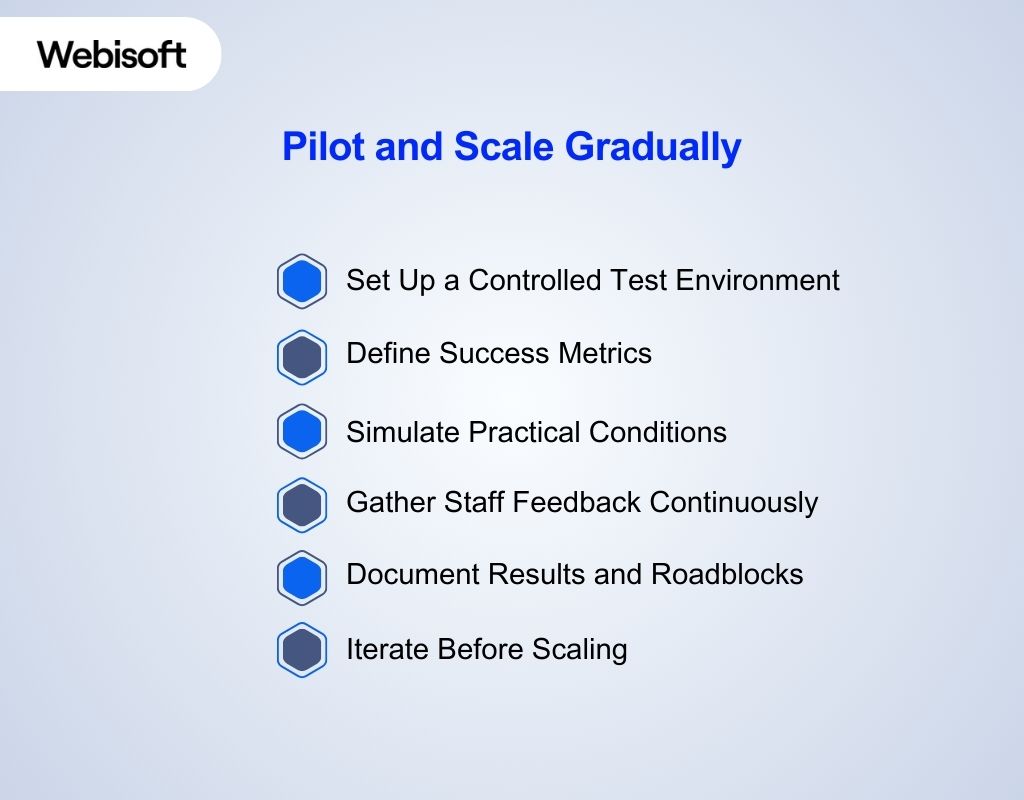 Running a pilot means launching a small-scale, controlled version of your blockchain solution in a real-world healthcare setting to test its performance, usability, and impact before full implementation. Here’s how you can run a pilot before integrating blockchain technology in medical industry:
Running a pilot means launching a small-scale, controlled version of your blockchain solution in a real-world healthcare setting to test its performance, usability, and impact before full implementation. Here’s how you can run a pilot before integrating blockchain technology in medical industry:
Set Up a Controlled Test Environment
Don’t test in your live production system. Build a sandbox or staging environment that mirrors real workflows without risking patient data.
Define Success Metrics
Set clear KPIs: data accuracy, processing time, system uptime, error reduction, and user adoption. You can’t prove value without something to measure.
Simulate Practical Conditions
Run the pilot under realistic conditions: multiple users, actual data flows (de-identified), and standard integrations with EHRs or billing systems.
Gather Staff Feedback Continuously
Interview users regularly. Track where the system supports them and where it gets in the way. UX makes or breaks adoption.
Document Results and Roadblocks
Capture what worked, what failed, and what needs fixing. This is your roadmap for scaling and your ammo for leadership buy-in.
Iterate Before Scaling
Refine the system based on pilot feedback before you expand to more departments, hospitals, or external partners.
Step 6: Integrate the Blockchain System
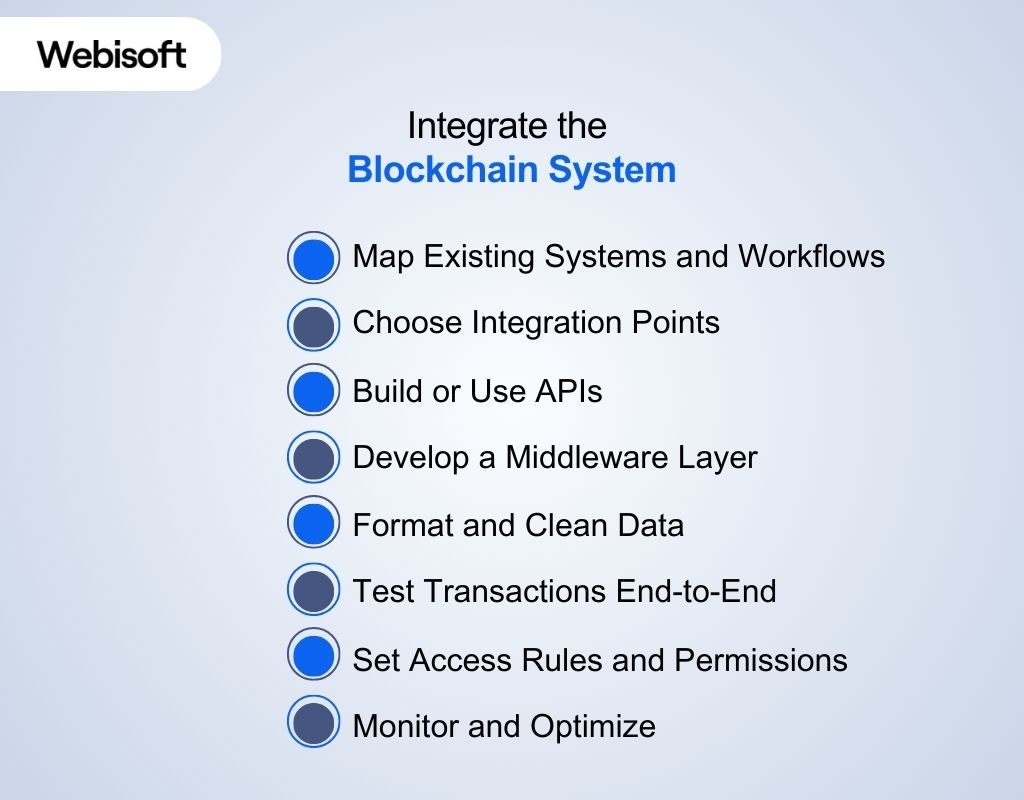 For blockchain technology in the medical industry to actually work, it has to work with what you already have. Here’s how integration typically happens:
For blockchain technology in the medical industry to actually work, it has to work with what you already have. Here’s how integration typically happens:
Map Existing Systems and Workflows
Identify the key platforms involved, such as EHRs, billing, lab systems, etc., etc., and understand how data currently moves between them.
Choose Integration Points
Decide where blockchain fits: Will it log record updates? Track prescriptions? Automate claims? Focus on one or two clear connection points.
Build or Use APIs
Use existing APIs (if available) to connect your legacy systems to the blockchain. If APIs don’t exist, you’ll need middleware to connect the gap. Need help from experts? Webisoft is available to assist at any time.
Develop a Middleware Layer
Middleware handles data translation, formatting, and transfer. It ensures that blockchain communicates smoothly with different systems, even older ones.
Format and Clean Data
Standardize how your data is labeled, stored, and shared. Blockchain development in healthcare doesn’t fix dirty data; it just locks it in permanently.
Test Transactions End-to-End
Simulate real transactions between systems: EHR entries, billing events, or consent updates. Verify they flow correctly and securely to the blockchain.
Set Access Rules and Permissions
Use role-based access to define who can read or write blockchain data. This is crucial for HIPAA/GDPR compliance.
Monitor and Optimize
Track performance, data accuracy, and latency. Adjust your integration layer to improve reliability and reduce any friction.
Launch blockchain in your healthcare service with Webisoft now!
Schedule a free consultation – Develop a blockchain technology for your service today!
Public vs. Private Blockchains in Healthcare
Now, let’s learn about public vs. private blockchains. Because not all blockchains work the same way.
Public blockchains
These blockchains are open to anyone. Bitcoin and Ethereum fall into this bucket. Anyone can join, see the data (if it’s not encrypted), and contribute to validating new transactions. That’s great for transparency but usually too exposed for sensitive medical data.
Private blockchains
In contrast, private blockchains are more your speed in healthcare. They’re permissioned. You only get in if you’re invited, and your access is controlled. Hospitals, payers, and labs, they all get a role, but no one sees more than they should. Private blockchains are faster, more secure, and actually useful when you’re handling real patient data under HIPAA or GDPR.
Cost Analysis: What It Takes to Implement Blockchain in Healthcare
Blockchain isn’t cheap to implement. The cost of each implementation step can vary. Before you jump into learning how to use blockchain in healthcare, here’s the breakdown of the approximate cost analysis:
| Category | What It Includes | Estimated Cost |
| System integration | Connecting blockchain to EHRs, billing, labs, imaging | $150,000–$500,000 |
| Infrastructure setup | Cloud hosting, nodes, secure servers, redundancy | $50,000–$200,000 |
| Smart contract development | Automation for claims, access permissions, prior authorizations | $75,000–$250,000 |
| Security and compliance | HIPAA, GDPR compliance layers, encryption, identity management | $100,000–$300,000 |
| Pilot program | Limited rollout with 1–2 departments or use cases | $25,000–$100,000 |
| Training and onboarding | Staff training, technical onboarding, change management | $10,000–$50,000 |
| Vendor/platform fees | Blockchain-as-a-service (BaaS) platforms, licensing, API access | $5,000–$25,000/month |
| Ongoing maintenance | Technical support, updates, audits, uptime monitoring | $50,000–$150,000/year |
Websisoft can help make a lot of these costs less. We have expert engineers who can make you the best smart contract for the healthcare industry. We can also help with setting up the whole infrastructure. Get our free consultancy today.
Why Healthcare Needs Blockchain
 Hospitals deal with life-and-death situations, but their data systems? Not even close to that level of reliability. Here are some benefits of blockchain in healthcare:
Hospitals deal with life-and-death situations, but their data systems? Not even close to that level of reliability. Here are some benefits of blockchain in healthcare:
1. Health Data Is Scattered and Hard to Access
A patient’s info lives in separate systems: lab, radiology, pharmacy, and billing. None of them talk to each other. If a doctor needs a full view, they either wait or guess. Why blockchain helps: It creates a secure, shared layer where verified data from different sources connects in real time. No duplication. No blind spots.
2. Records Are Easy to Alter Without a Trace
Right now, if someone tweaks a diagnosis or billing entry, there’s often no way to tell. Audit trails exist, but they’re patchy or buried. Why blockchain helps: Every change is logged permanently. Not edited, but recorded as a new, timestamped event. You know exactly who changed what and when.
3. Patient Privacy Is Constantly at Risk
Healthcare breaches aren’t rare; they’re expected. Data is stored in centralized systems with big targets on their backs. One leak, and millions of records are exposed. Why blockchain helps: It decentralizes data. There’s no single entry point to attack. Patients also get more control over who accesses their information.
4. Billing Fraud Is a Multi-Billion-Dollar Problem
Hospitals lose billions every year to fake claims, billing for services never performed, or duplicate charges. Current systems don’t catch it fast enough. Why blockchain helps: It makes billing transparent and traceable. Every charge is verified against the actual care delivered and logged permanently.
5. There’s No Single Version of the Truth
You’ve got doctors, insurers, and labs each working off different records. That leads to delays, miscommunication, and mistakes in patient care. Why blockchain helps: Everyone works off the same data ledger. It’s real-time, verified, and consistent, no matter where you sit in the system.
6. Administrative Bottlenecks Slow Everything Down
Authorizations, audits, and cross-checks kill speed. The system relies on back-and-forth emails, approvals, and endless paper trails. Why blockchain helps: It can automate many of these steps using smart contracts, self-executing agreements that trigger actions when conditions are met. This is how blockchain improves healthcare.
Patient Perspective: How Blockchain Impacts the Healthcare Experience
 How to use blockchain in healthcare is not limited to doctors and admin panels only; you also need to understand the patient experience with it. Here is a brief explanation of the patient’s perspective:
How to use blockchain in healthcare is not limited to doctors and admin panels only; you also need to understand the patient experience with it. Here is a brief explanation of the patient’s perspective:
Patients Can Control and Share Their Data Securely
When healthcare runs on a blockchain-based system, patients are given a digital identity or key. Using this, they can:
- Log in to a portal or app that shows their health records stored across different providers.
- Choose exactly what to share, like test results, prescriptions, or visit history.
- Set time limits or revoke access entirely, just like managing file permissions in Google Drive or Dropbox.
- Authorize access through digital signatures, which are cryptographically secure and verifiable.
Instead of calling the clinic, filling out forms, or faxing documents, a patient can grant their cardiologist access to only their heart-related records for a week. And after that? The access shuts off automatically unless extended. This gives patients direct, real-time control, without needing to store, download, or email any files. Everything stays secure on the blockchain, visible only to those they approve.
Increased trust through transparency
Patients can see who accessed their records, when, and why. Every action is logged and unchangeable. That transparency builds trust, especially for people who are used to having no visibility into how their data is handled behind the scenes.
Challenges in patient adoption and understanding
While blockchain offers control, most patients aren’t familiar with how it works. The tech barrier can be high. If the tools aren’t simple and intuitive, patients may feel confused or overwhelmed, which could slow adoption and limit the full benefits of blockchain in real-world settings.
Challenges & Considerations of Blockchain in Healthcare
Understanding how to use blockchain in healthcare isn’t just about what the technology can do; it’s about what might get in the way. Here are some common challenges of using blockchain in healthcare:
- Regulatory Conflicts: Blockchain’s immutability can clash with healthcare laws like HIPAA and GDPR, especially around data deletion and patient rights.
- High Upfront Costs: Building and integrating blockchain isn’t cheap, especially when developing smart contracts and ensuring compliance from day one.
- Scalability Limits: Many blockchain platforms struggle to handle the high transaction volumes needed by large hospitals or national systems.
- Legacy System Compatibility: Most hospitals still run outdated EHRs. Integrating blockchain into these systems requires heavy customization and reliable middleware.
- Data Standardization Gaps: Without consistent formats across providers, blockchain networks risk becoming fragmented and unreliable.
- Unclear Governance: There must be clear rules on who can write, access, and verify data, or the entire system becomes chaotic.
- Data Format Mismatches: Healthcare data varies across systems. If one hospital logs blood pressure differently from another, syncing that on the blockchain creates confusion instead of clarity.
Innovative Approaches and Future Trends of Blockchain in Healthcare
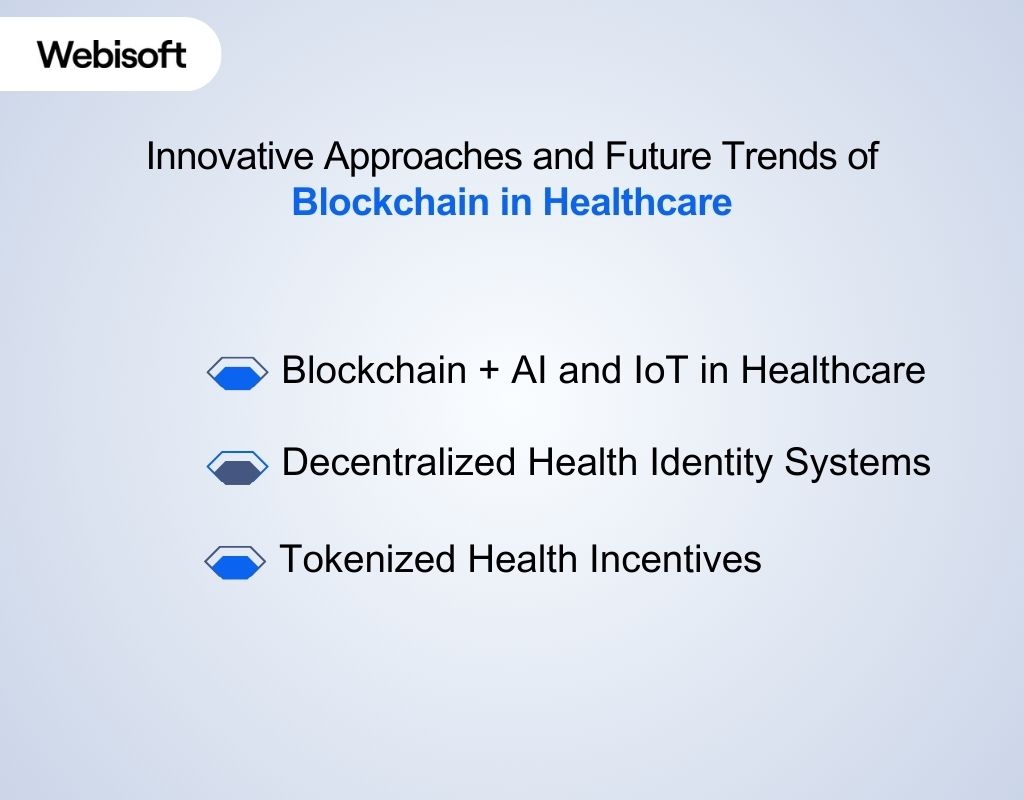 Despite the challenges, blockchain is evolving fast. The tech is maturing, and smart teams are combining it with other innovations to push healthcare forward.
Despite the challenges, blockchain is evolving fast. The tech is maturing, and smart teams are combining it with other innovations to push healthcare forward.
Blockchain + AI and IoT in Healthcare
The duo of blockchain and AI can simplify a lot of healthcare management tasks. AI analyzes data, and IoT in blockchain technology collects it. Blockchain secures and validates it. Imagine wearable monitoring vitals in real time, feeding data to an AI model, while blockchain ensures the record hasn’t been tampered with. That’s already happening in clinical trials and remote care.
Decentralized Health Identity Systems
Blockchain enables portable, digital health IDs. Patients carry their history in a secure, verified format and use it across providers, regions, and even countries. No more “starting over” every time you switch care.
Tokenized Health Incentives
Healthcare providers and insurers are experimenting with blockchain-based rewards —
- Tokens for attending appointments
- Completing screenings
- Managing chronic conditions
It’s behavior-driven care, with verified proof of action, and it’s easier to manage than legacy loyalty programs.
How Can Webisoft Help You Adding Blockchain in Your Healthcare Service
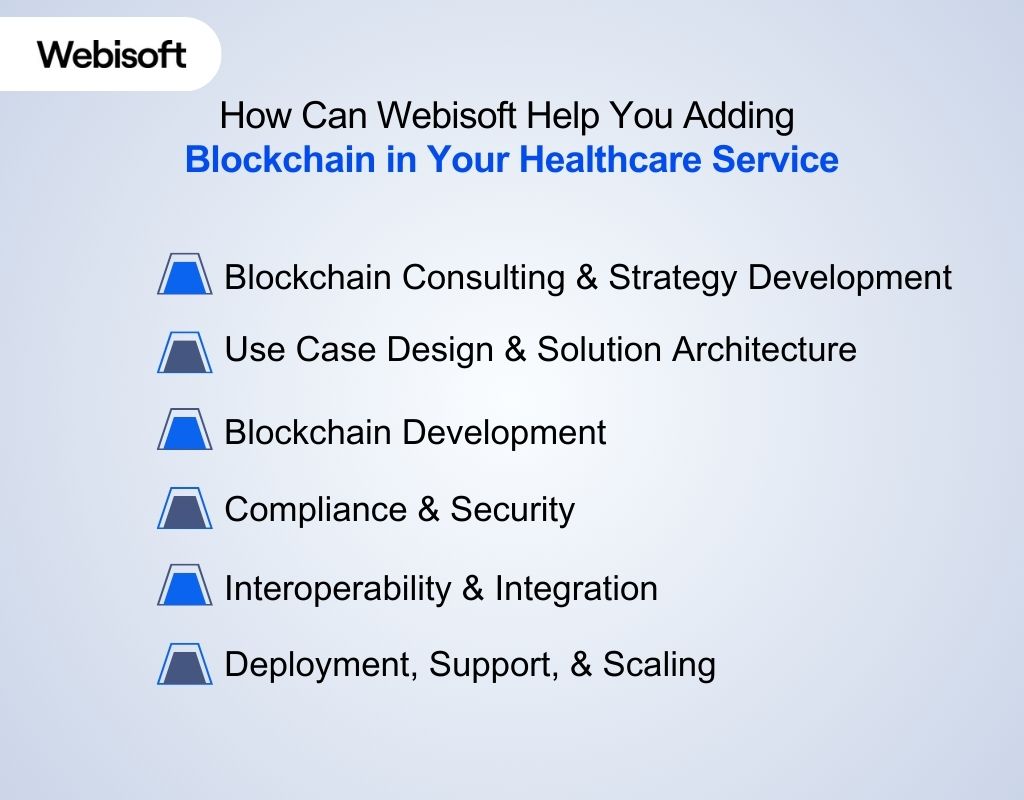 If you need professional help integrating blockchain technology into your healthcare service, Webisoft is here to help at any time with a solid strategy. How does Webisoft help?
If you need professional help integrating blockchain technology into your healthcare service, Webisoft is here to help at any time with a solid strategy. How does Webisoft help?
1. Blockchain Consulting & Strategy Development
Webisoft would begin with a learning and strategy phase, identifying:
- Key pain points in your healthcare service (e.g., data integrity, interoperability, privacy).
- Areas that can benefit from blockchain include patient records, billing, supply chain tracking, or clinical trials.
2. Use Case Design & Solution Architecture
They help define suitable blockchain use cases, such as:
- Electronic Health Records (EHR): Immutable, interoperable patient data across providers.
- Consent Management: Smart contracts for managing patient consent and data access.
- Medical Supply Chain: Track the provenance and integrity of pharmaceuticals and medical devices.
- Claims & Billing: Automate and verify transactions via smart contracts.
3. Blockchain Development
Webisoft can build:
- Private or consortium blockchain networks (e.g., using Hyperledger Fabric).
- Smart contracts to automate logic like patient data sharing or insurance verification.
- Tokenization systems (if needed for incentives, access, or governance).
4. Compliance & Security
They ensure HIPAA, GDPR, and other compliance by:
- Using permissioned blockchains to control access.
- Integrating encryption, identity verification, and audit trails.
5. Interoperability & Integration
Webisoft can integrate blockchain with your existing systems. Such as —
- EHR systems (e.g., Epic, Cerner)
- Telehealth platforms
- Insurance databases
- IoT medical devices
6. Deployment, Support, & Scaling
In addition to integrating, Webisoft helps launch and scale with post-service support. They assist in:
- Cloud or on-premises deployment
- Continuous monitoring and updates
- Scaling the blockchain system as your service grows
Ready to transform your healthcare service with blockchain? Contact Webisoft for blockchain consultation to discuss your project and unlock the benefits of secure, innovative healthcare solutions.
Launch blockchain in your healthcare service with Webisoft now!
Schedule a free consultation – Develop a blockchain technology for your service today!
Conclusion
So, how to use blockchain in healthcare? Using blockchain in healthcare can make managing patient data safer, more transparent, and more efficient. It helps protect records, reduce fraud, and simplify tasks like billing and insurance. By adopting this technology, healthcare providers can offer better care, improve their operations, and build trust with patients. Looking for a reliable and trustworthy partner for building a blockchain in your medical service? Contact Webisoft to book a quote.
FAQs
Here are some common questions regarding blockchain in healthcare:
What is the role of smart contracts in healthcare?
Smart contracts in healthcare automate processes like billing, patient consent, and insurance claims. They ensure that transactions are transparent, secure, and completed only when predefined conditions are met, reducing human error and fraud.
What are the top blockchain platforms for healthcare?
Some of the top blockchain platforms for healthcare include IBM Blockchain, Healthereum, Medicalchain, and Solve.Care.
What companies are using blockchain in healthcare?
Companies like IBM, Change Healthcare, and Medicalchain are using blockchain in healthcare to enhance data sharing, improve patient outcomes, and streamline administrative processes.


